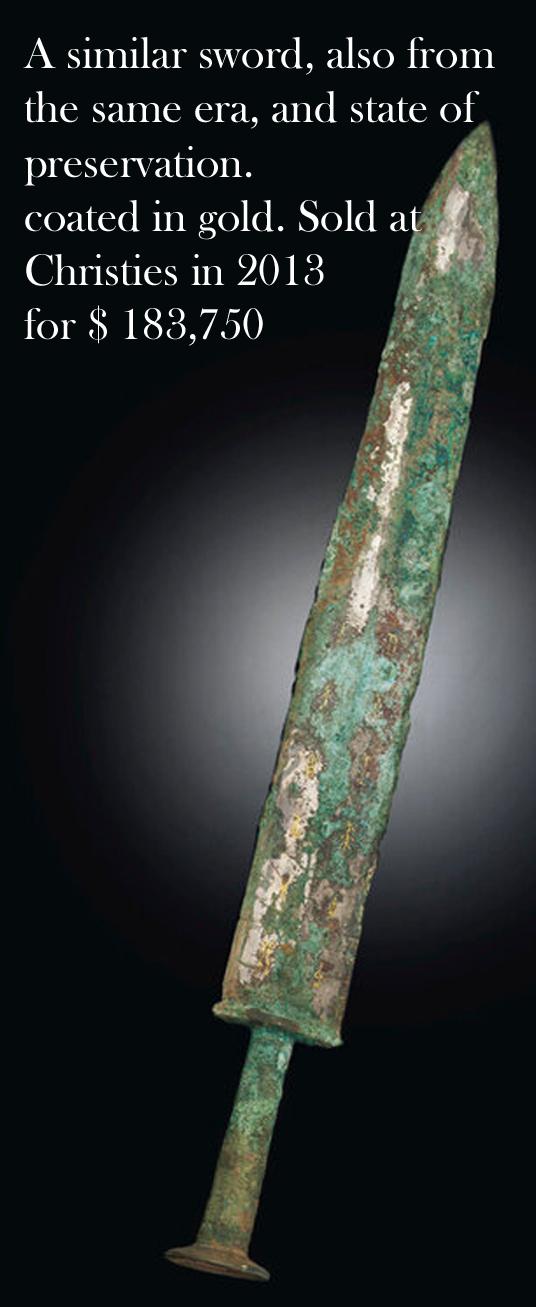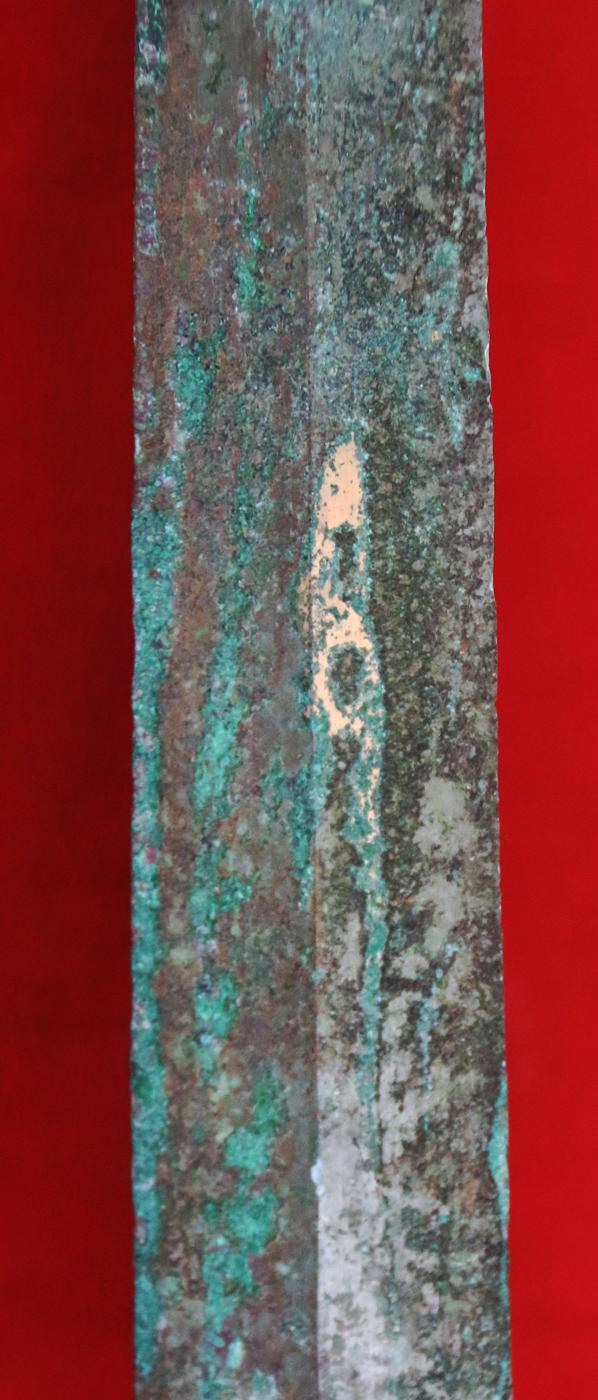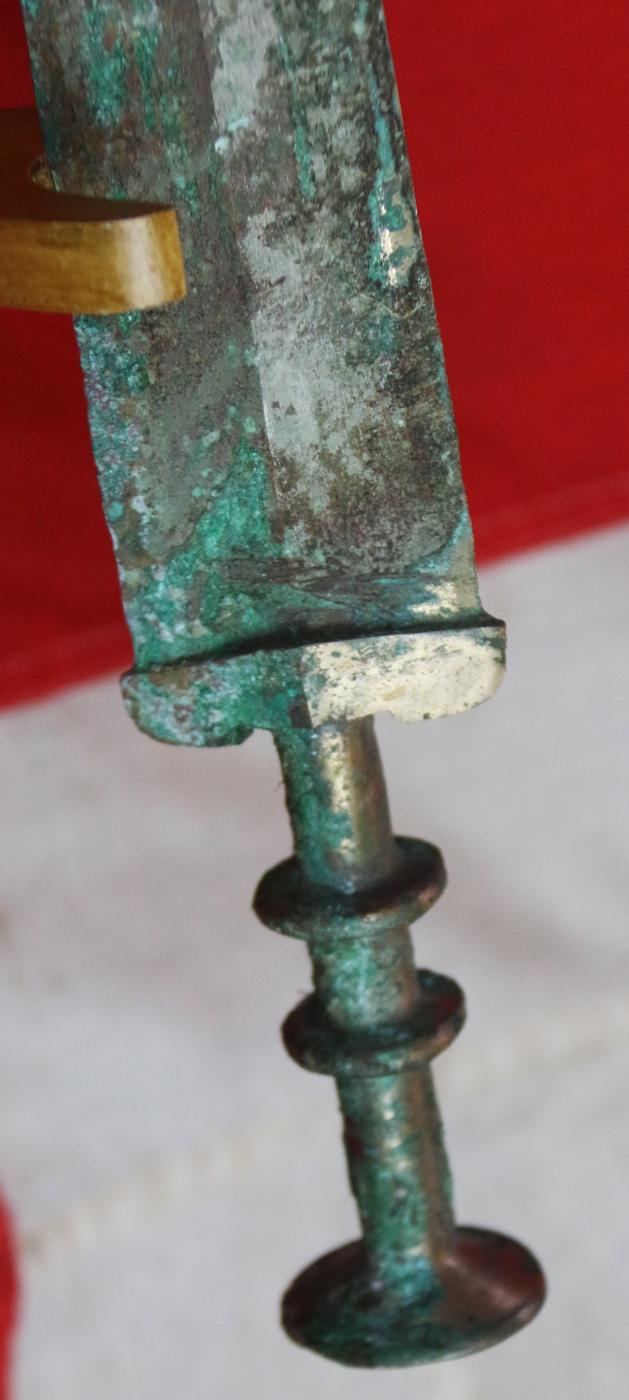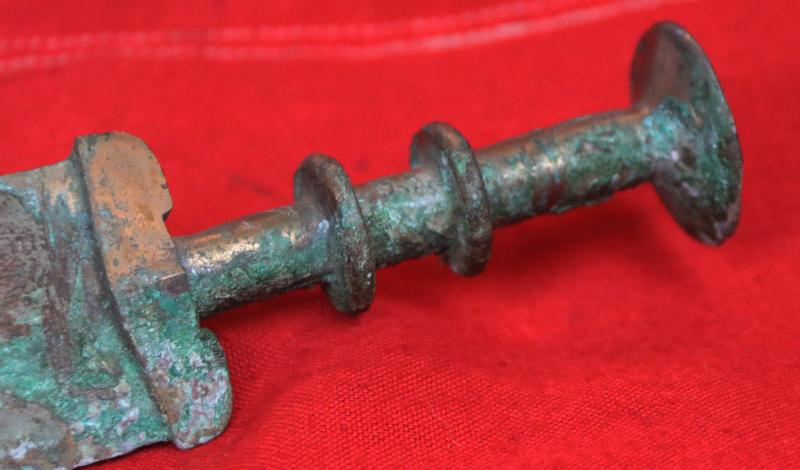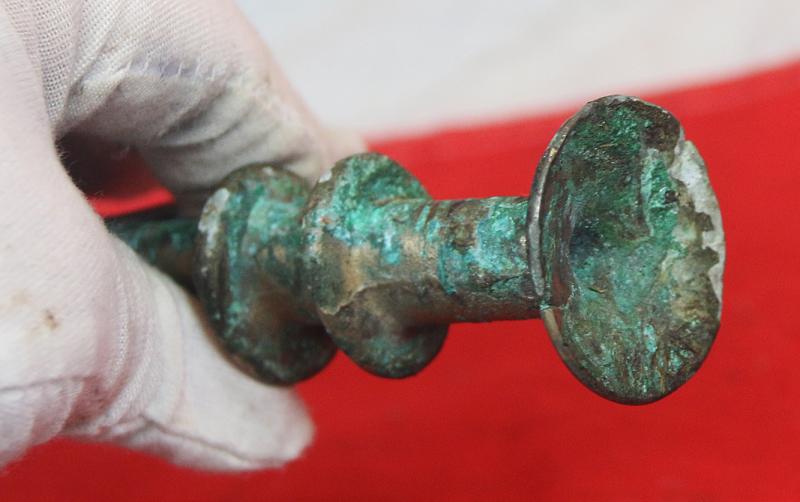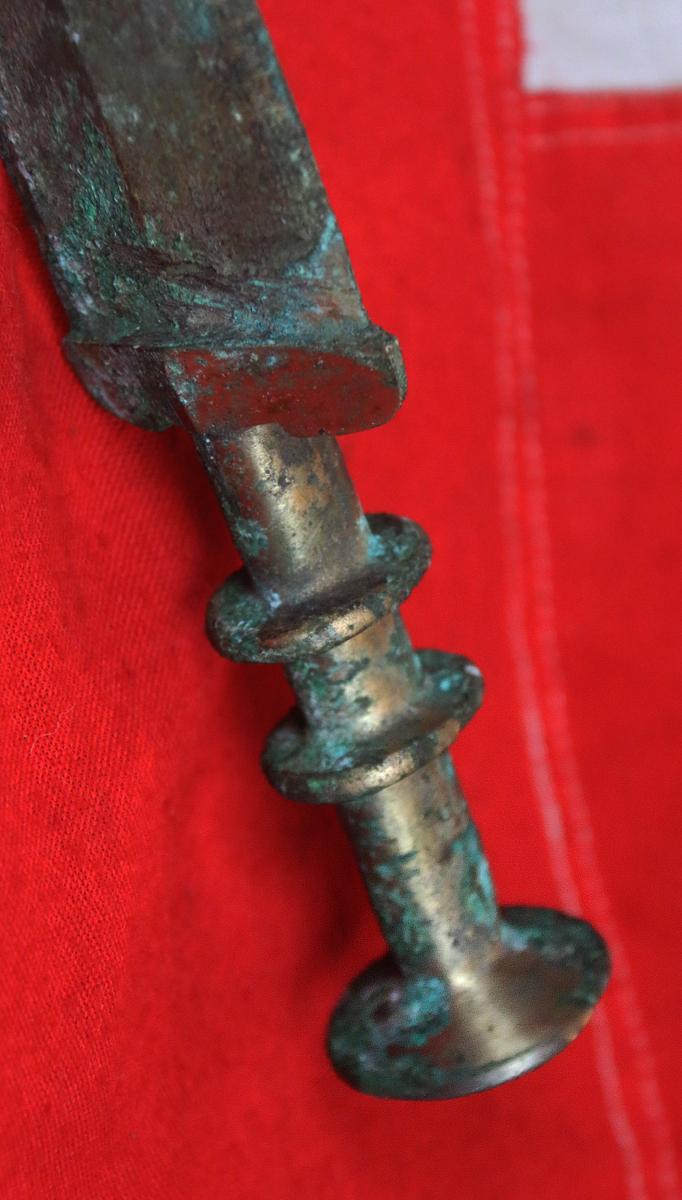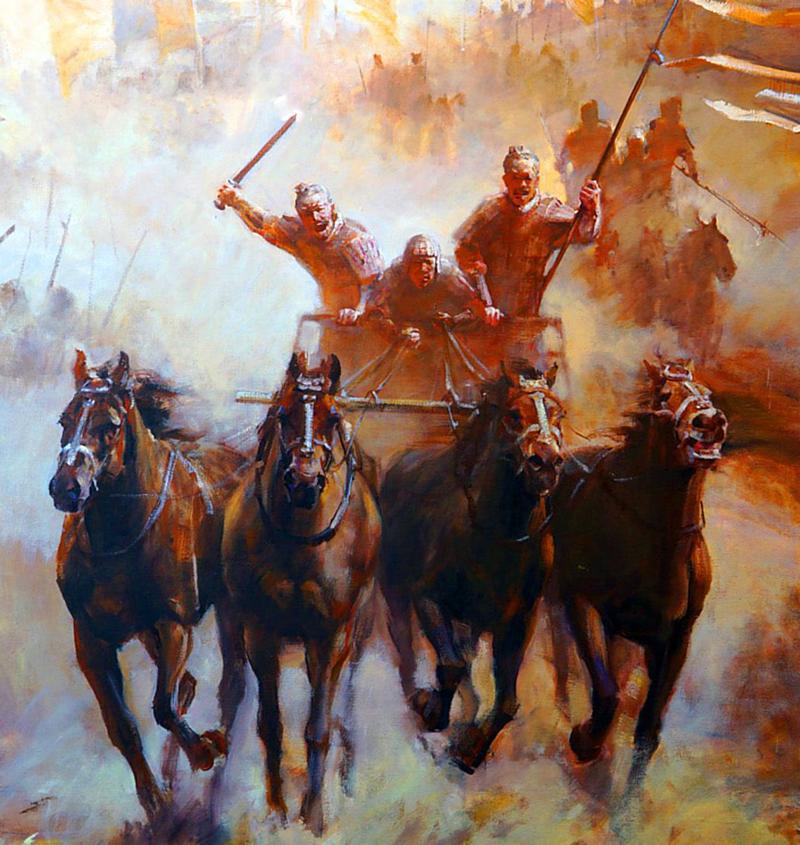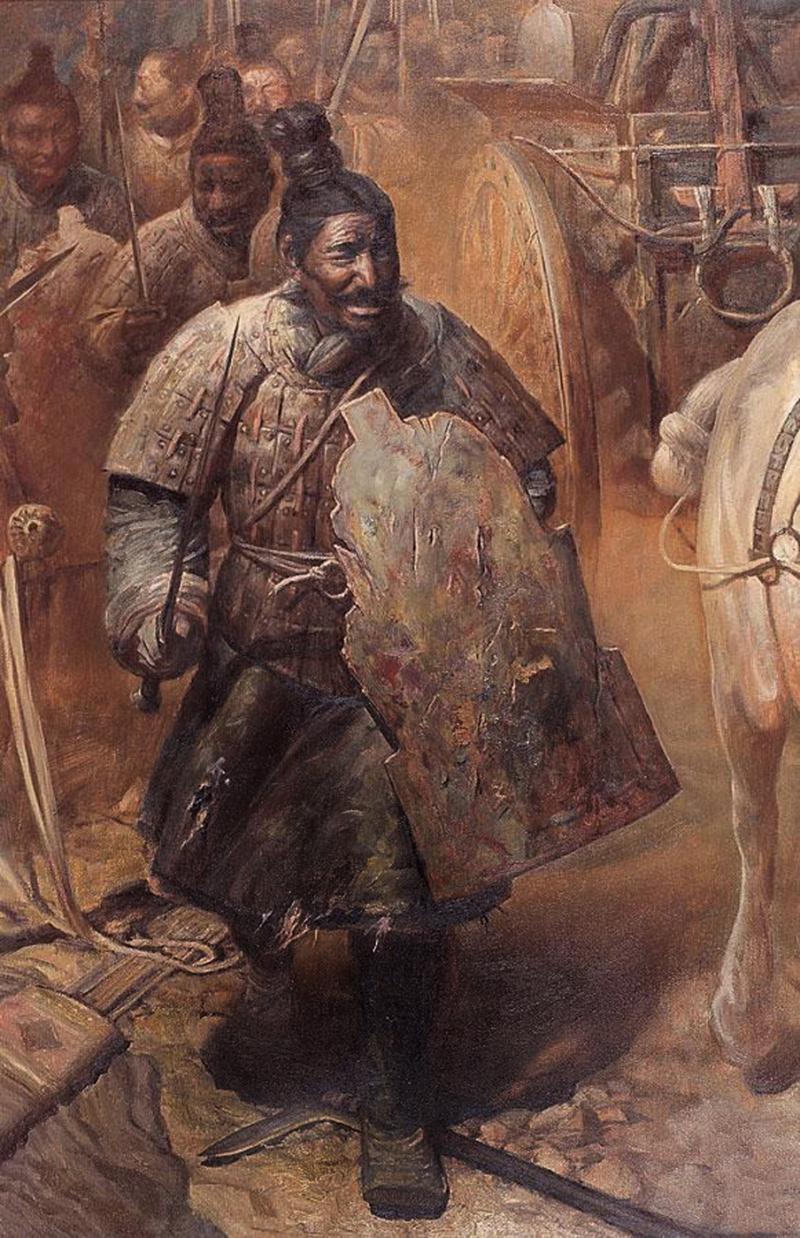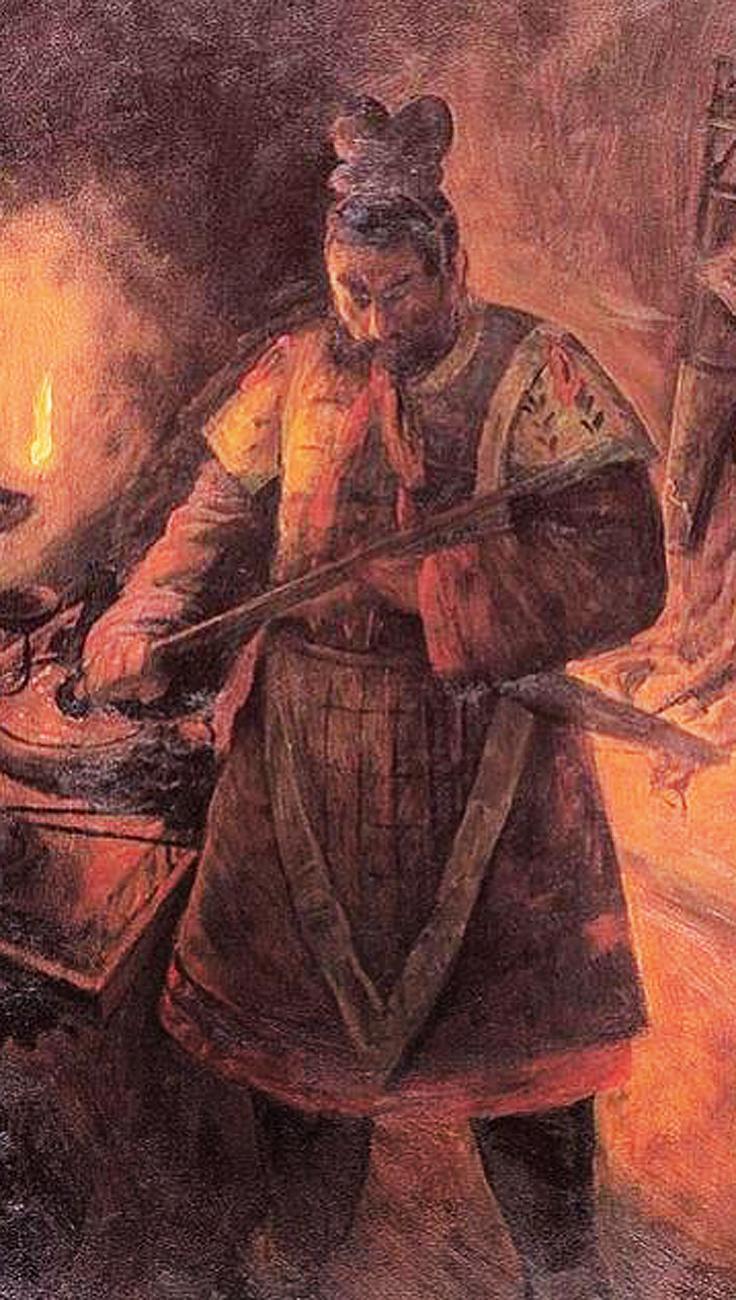Rare, Archaic Chinese Warrior Prince's Bronze Jian Sword, Overlaid With Gold, Auspicious Metal, Around 2,400 to 2,600 Years Old, From the Zhou Dynasty to the Chin Dynasty, Including the Period of Sun-Tzu'. Likely of The Kingdom of Yue
Chinese Bronze 'Two Ring' Jian sword, a bronze alloy construction, with traces of pure gold, including the gold onlay of a dragon {see photos 1 and 3 in the gallery} with the Chinese ‘Auspicious Metal’ {gold}, overlay, and now with up to 2400 years of natural aged patination and surface encrustations, made and used in the era of China's Seven Kingdoms period, likely with royal connections in the Kingdom of Yue, up to the latter part of the Eastern Zhou dynasty (475 BC). It is incredibly rare to find a sword from this period of ancient history with gold decor. It's surface is covered in superb patination and age encrustations, with various areas showing traces of layered pure gold. Of course, naturally, in its day, it would have been visibly fully covered in gold and look quite magnificent. It would have undoubtedly have been made for an ancient Chinese warrior Prince or general, absolutely a man of the highest possible status within the King’s army. 535mms long, weight 800gms.
Formerly of the Anthony Dove Collection, one of the foremost collectors of ancient Chinese swords, and joint author on the seminal academic research paper on the authentication of ancient Chinese swords and their metallurgical construction.
We show in the gallery photographs of another sword very similar, from the same era and reign, a non ringed hilt type, that was once also covered in gold, but now encrusted with age, like ours, that sold in 2013 for $183,750.
However, that gold sword was detailed and inlaid with surviving archaic script, somewhat like our other engraved two ring sword, that has revealed, through diligent effort, a potential translation, and the name of its owner. In a fashion, our two similar swords, but combined, would have the merged result of that single gold sword. Yet at less than a small percentage of the cost of the Christie’s sword
The Zhou script engraved on that other gold sword may state the following : Gongwu wang Guang ? yi ji jin zi zuo yong jian ('King Guang of the State of Gongwu forged this sword with auspicous metal for his usage')
From a large collection of antiquities, swords daggers, and rings, that recently arrived, many pieces sold for the part benefit of the Westminster Abbey fund, and the Metropolitan Museum fund. Formerly the property of a highly regarded renown British expert and collector, who has collaborated with museum experts, such as the Wallace Collection, on the origins, forms, styles and metallurgical investigations on ancient Chinese Bronze Age antiquities, and early British silver.
Swords of this type are called “two-ring” swords because of the prominent rings located on the hilt. this is the very type of sword used by the highest ranking officer warriors or princes alongside the world renowned General Sun Tzu, in the Kingdom of Wu, {although this sword is more likely from the Kingdom of Yueh} who is thought by many to be the finest general, philosopher and military tactician who ever lived. His 2500 year old book on the methods of warfare, tactics and psychology are still taught and highly revered in practically every officer training college throughout the world.
We show a painting in the gallery of a chariot charge by a Zhou dynasty warrior armed with this very form of sword.
The Chinese term for this form of weapon is “Jian” which refers to a double-edged sword. This style of Jian is generally attributed to either the Wu or the Yue state. The sword has straight graduated edges reducing to a pointed tip, which may indicate an earlier period Jian.
The blade is heavy with a midrib and tapered edges with seal script engraving on both sides of the bottom section of the blade near the hilt. See the photo in the gallery that shows a close up of the section of blade with the seal script.
A very impressive original ancient Chinese sword with a long, straight blade with a raised, linear ridge down its centre. It has a shallow, short guard. The thin handle would have had leather or some other organic material such as leather or hemp cord, wrapped around it to form a grip. At the top is a broad, round pommel.
A very similar sword had a detailed metallurgical analysis carried out at the Wallace Collection was measured by Graham McArthur in the Conservation Department of the Wallace Collection at a number of points near the edge using a Branson Krautkramer electronic surface hardness tester giving results ranging from 158 to 289 VPH with an average of 247 VPH, and thus thought to be from 500 BC. That particular sword, had a number of features in common with one in the Catalogue of the Warner Jennings Collection in the Chinese National Palace Museum, Peking, that is considered to have royal associations with a king of Yueh.
The Seven Kingdom or Warring States period in Chinese history was one of instability and conflict between many smaller Kingdom-states. The period officially ended when China was unified under the first Emperor of China, Qin pronounced Chin Shi Huang Di in 221 BC. It is from him that China gained its name.
The Zhou Dynasty (1046-256 BCE) was among the most culturally significant of the early Chinese dynasties and the longest lasting of any in China's history, divided into two periods: Western Zhou (1046-771 BCE) and Eastern Zhou (771-256 BCE). It followed the Shang Dynasty (c. 1600-1046 BCE), and preceded the Qin Dynasty (221-206 BCE, pronounced “chin”) which gave China its name.
In the early years of the Spring and Autumn Period, (770-476 BC) chivalry in battle was still observed and all seven states used the same tactics resulting in a series of stalemates since, whenever one engaged with another in battle, neither could gain an advantage. In time, this repetition of seemingly endless, and completely futile, warfare became simply the way of life for the people of China during the era now referred to as the Warring States Period. The famous work The Art of War by Sun-Tzu (l. c. 500 BCE) was written during this time, recording precepts and tactics one could use to gain advantage over an opponent, win the war, and establish peace.
Sun Tzu was a Chinese general, military strategist, writer, and philosopher who lived in the Eastern Zhou period of ancient China. Sun Tzu is traditionally credited as the author of The Art of War, an influential work of military strategy that has affected both Western and East Asian philosophy and military thinking. His works focus much more on alternatives to battle, such as stratagem, delay, the use of spies and alternatives to war itself, the making and keeping of alliances, the uses of deceit, and a willingness to submit, at least temporarily, to more powerful foes. Sun Tzu is revered in Chinese and East Asian culture as a legendary historical and military figure. His birth name was Sun Wu and he was known outside of his family by his courtesy name Changqing The name Sun Tzu by which he is more popularly known is an honorific which means "Master Sun".
Sun Tzu's historicity is uncertain. The Han dynasty historian Sima Qian and other traditional Chinese historians placed him as a minister to King Helü of Wu and dated his lifetime to 544–496 BC. Modern scholars accepting his historicity place the extant text of The Art of War in the later Warring States period based on its style of composition and its descriptions of warfare. Traditional accounts state that the general's descendant Sun Bin wrote a treatise on military tactics, also titled The Art of War. Since Sun Wu and Sun Bin were referred to as Sun Tzu in classical Chinese texts, some historians believed them identical, prior to the rediscovery of Sun Bin's treatise in 1972.
Sun Tzu's work has been praised and employed in East Asian warfare since its composition. During the twentieth century, The Art of War grew in popularity and saw practical use in Western society as well. It continues to influence many competitive endeavours in the world, including culture, politics, business and sports.
The ancient Chinese people worshipped the bronze and iron swords, where they reached a point of magic and myth, regarding the swords as “ancient holy items”. Because they were easy to carry, elegant to wear and quick to use, bronze swords were considered a status symbol and an honour for kings, emperors, scholars, chivalrous experts, merchants, as well as common people during ancient dynasties. For example, Confucius claimed himself to be a knight, not a scholar, and carried a sword when he went out. The most famous ancient bronze sword is called the “Sword of Gou Jian”.
The Warring States period saw a transition in military styles, from bronze weaponry and chariot-based fighting to iron and cavalry. However, the old period was still revered. Despite the cost of manufacturing bronze swords like this on a mass scale, this particular style of duan jian – a double-edged straight sword – was used in China for approximately 2,500 years. Finely made bronze weapons such as this one were signs of prestige, wealth, and fighting prowess used in both ceremonial and funerary contexts. For example, swords were worn by the Emperor and his officials in ceremonial or official dress, attached to the belt with jade ornaments.
This is one of a stunning collection of original archaic bronze age Zhou dynasty weaponry we have just acquired. Many are near identical to other similar examples held in the Metropolitan in New York, the British royal collection, and such as the Hunan Provincial Museum, Hunan, China. As with all our items, every piece is accompanied by a certificate of authenticity. Just over 26 inches long overall.
From the Tony Dove F.S.A. Collection, formed circa 1970's, one of England’s most revered and respected collectors, especially early silver, & he was a past honorary President of London’s Silver Spoon Society.
Other bronze swords bearing inscriptions inlaid in gold include the example dated to the 5th century BC in the Freer Gallery of Art, illustrated by T. Lawton, Chinese Art of the Warring States Period, Change and Continuity, 480-222 BC , Washington, DC , 1982, p. 70-71, no. 28, and one in the Musée Guimet dated 5th-4th century BC, illustrated by C. Delacour, De bronze, d'or et d'argent, Sumptuary Arts of China , Paris, 2001, p. 131. Both the Freer sword and the Guimet sword bear the same twenty-character inscription, arranged in ten characters to each side, which Thomas Lawton translates as, "On the auspicious day jen-wu, this sword was made for righteous use .
We show in the gallery, another very similar sword in a most similar state of aged preservation, but, with surviving gold inlaid archaic script upon the blade. It was sold at Christies in 2013, for $183,,750 . Lot number 1234. A very rare and important gold-inlaid bronze sword, Eastern Zhou dynasty, late 6th-early 5th century BC; 19 3/8 in. (49.3 cm.) long. Estimate 150,000 - USD 250,000. Price realised USD $183,750. Formerly of the Arthur M. Sackler Collections, New York.
Ref; SOME OBSERVATIONS ON EARLY CHINESE BRONZE SWORDS
By
Anthony Dove and Alan Williams {The Wallace Collection} 65 publications
Code: 24842
7775.00 GBP


